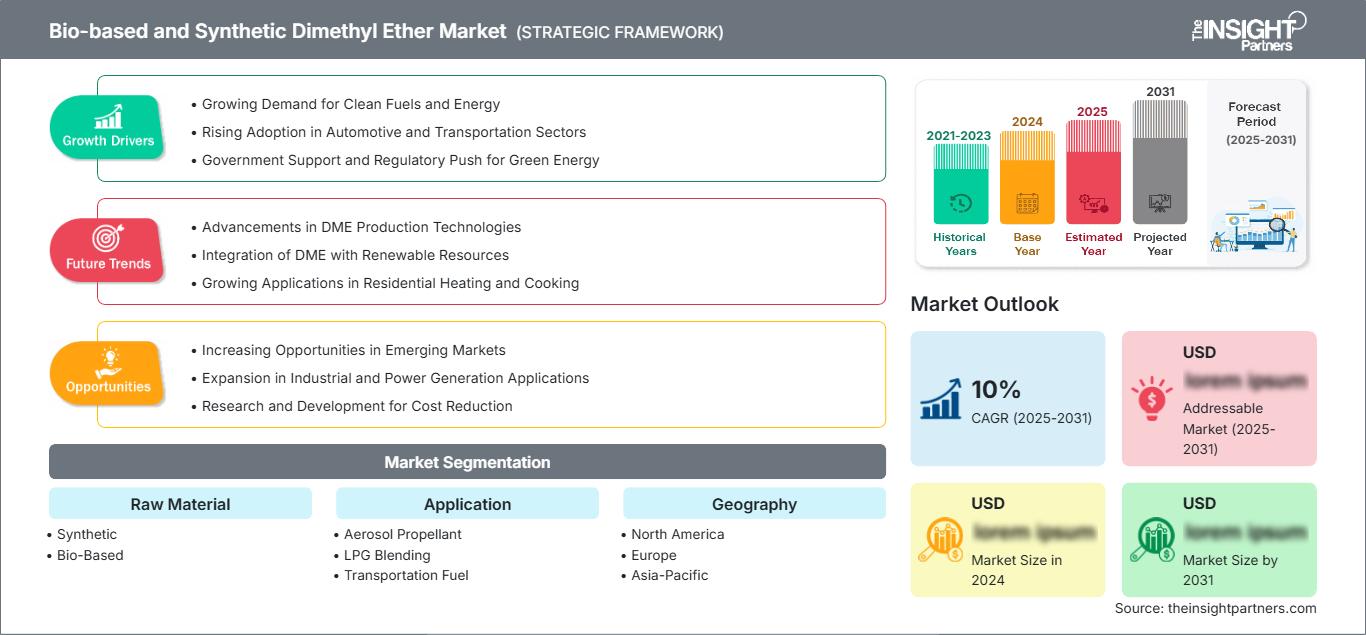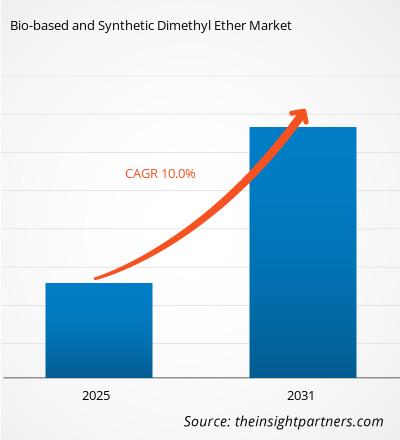Le marché du diméthyléther biosourcé et synthétique devrait atteindre 6,61 milliards de dollars américains d'ici 2031. Ce marché devrait enregistrer un TCAC de 7,7 % entre 2025 et 2031.
Ce rapport présente une analyse basée sur les matières premières (synthétiques et biosourcées). Il est segmenté par application (propulseur d'aérosol, mélange de GPL, carburant pour le transport, carburant pour la production d'énergie, matière première chimique et autres). L'analyse mondiale est ensuite ventilée au niveau régional et par principaux pays. La taille du marché et les prévisions aux niveaux mondial, régional et national pour tous les segments clés sont couvertes par le rapport. Les valeurs sont exprimées en dollars américains. Le rapport fournit des statistiques clés sur la position des principaux acteurs du marché et présente les tendances et les opportunités.
Objectif du rapport
Le rapport « Marché du diméthyléther biosourcé et synthétique » de The Insight Partners vise à décrire le paysage actuel et la croissance future, les principaux facteurs de croissance, les défis et les opportunités.
Objectif du rapport
Le rapport « Marché du diméthyléther biosourcé et synthétique » de The Insight Partners vise à décrire le paysage actuel et la croissance future, les principaux facteurs de croissance, les défis et les opportunités.
Cela permettra d'éclairer divers acteurs économiques, tels que :- Fournisseurs de technologies/Fabricants : Pour comprendre l'évolution de la dynamique du marché et identifier les opportunités de croissance potentielles, afin de prendre des décisions stratégiques éclairées.
- Investisseurs : Pour réaliser une analyse approfondie des tendances concernant le taux de croissance du marché, les projections financières et les opportunités tout au long de la chaîne de valeur.
- Organismes de réglementation : Pour encadrer les politiques et les activités du marché afin de minimiser les abus, préserver la confiance des investisseurs et garantir l'intégrité et la stabilité du marché.
Segmentation du marché du diméthyléther biosourcé et synthétique : Matières premières
- Synthétique
- Biosourcé
Application
- Propulseur pour aérosols
- Mélange de GPL
- Carburant pour le transport
- Combustible pour la production d'énergie
- Matière première chimique
Vous bénéficierez d’une personnalisation sur n’importe quel rapport - gratuitement - y compris des parties de ce rapport, ou une analyse au niveau du pays, un pack de données Excel, ainsi que de profiter d’offres exceptionnelles et de réductions pour les start-ups et les universités
Marché de l'éther diméthylique biosourcé et synthétique: Perspectives stratégiques

-
Obtenez les principales tendances clés du marché de ce rapport.Cet échantillon GRATUIT comprendra une analyse de données, allant des tendances du marché aux estimations et prévisions.
Facteurs de croissance du marché du diméthyléther biosourcé et synthétique
- Demande croissante de carburants et d'énergie propres : La demande mondiale croissante de sources d'énergie propres et durables est un moteur majeur du marché du diméthyléther (DME) biosourcé et synthétique. Le DME, carburant alternatif au GPL (gaz de pétrole liquéfié) et au diesel, offre des avantages environnementaux significatifs, notamment une réduction des émissions de carbone et de la pollution atmosphérique. Alors que les gouvernements et les industries s'efforcent de trouver des solutions énergétiques plus propres, le DME gagne du terrain en tant que source de carburant viable.
- Adoption croissante dans les secteurs de l'automobile et des transports : Les secteurs de l'automobile et des transports adoptent de plus en plus le diméthyléther (DME) comme carburant propre alternatif en raison de sa haute densité énergétique, de ses faibles émissions et de sa capacité à remplacer le diesel et le GPL dans les véhicules. La demande de DME dans le transport commercial, comme les camions et les autobus, est en croissance, car les constructeurs et les gouvernements recherchent des alternatives plus écologiques aux carburants traditionnels.
- Soutien gouvernemental et incitations réglementaires en faveur des énergies vertes : Les initiatives et politiques gouvernementales visant à promouvoir les sources d’énergie renouvelables et alternatives accélèrent la croissance du marché du DME biosourcé et synthétique. Les réglementations favorisant l’utilisation de carburants propres et encourageant la transition vers des émissions de carbone faibles créent des conditions favorables à l’adoption du DME, notamment dans des secteurs tels que les transports, le chauffage et la production d’électricité.
Tendances futures du marché du diméthyléther biosourcé et synthétique
- Progrès des technologies de production de DME : Les progrès technologiques dans la production de DME, notamment le développement de méthodes plus efficaces et économiques pour la synthèse de DME biosourcé, devraient stimuler la croissance du marché. Les innovations dans les procédés catalytiques, les technologies de conversion de la biomasse et les méthodes de production de carburants synthétiques rendent le DME biosourcé plus compétitif par rapport aux carburants conventionnels, favorisant ainsi son adoption dans de nombreux secteurs.
- Intégration du DME aux ressources renouvelables : L’intégration croissante du DME biosourcé aux ressources renouvelables, telles que la biomasse, les déchets agricoles et les technologies de capture du CO2, est une tendance émergente. Elle renforce non seulement la durabilité de la production de DME, mais contribue également à l’économie circulaire en réduisant les déchets et en favorisant l’utilisation de matières premières renouvelables. Cette tendance devrait accélérer l’adoption du DME biosourcé dans les applications d’énergie propre.
- Applications croissantes pour le chauffage et la cuisson résidentiels : La demande en DME biosourcé et synthétique est en hausse pour le chauffage et la cuisson résidentiels, notamment dans les régions où l’accès au gaz naturel est limité. Le DME peut être utilisé comme une alternative plus propre au GPL pour la cuisson et le chauffage, offrant des émissions réduites et une efficacité accrue. Face à la demande croissante de solutions de cuisson et de chauffage propres, l'adoption du DME dans le secteur résidentiel devrait augmenter.
Opportunités du marché du diméthyléther biosourcé et synthétique
- Opportunités croissantes sur les marchés émergents : L'industrialisation croissante et la demande énergétique grandissante sur les marchés émergents tels que l'Asie-Pacifique, l'Amérique latine et l'Afrique offrent d'importantes opportunités au marché du DME biosourcé et synthétique. Ces régions s'efforçant d'adopter des solutions énergétiques plus propres et de réduire la pollution atmosphérique, la demande de DME en tant que carburant alternatif plus propre et durable devrait augmenter.
- Expansion dans les applications industrielles et de production d'énergie : Le potentiel du diméthyléther en tant que carburant propre dans les applications industrielles, notamment la production d'énergie, ouvre de nouvelles perspectives de marché. Le DME suscite un intérêt croissant en tant que carburant alternatif pour les turbines, les chaudières et les générateurs dans les centrales électriques de toutes tailles, en raison de ses faibles émissions, de sa haute densité énergétique et de sa compatibilité avec les infrastructures existantes.
- Recherche et développement pour la réduction des coûts : Les efforts continus de recherche et développement visant à améliorer l’efficacité et l’extensibilité des méthodes de production de DME devraient stimuler la croissance du marché. Grâce aux progrès réalisés dans les procédés catalytiques et l’approvisionnement en matières premières, les coûts de production diminueront, rendant le DME biosourcé et synthétique de plus en plus compétitif par rapport aux carburants traditionnels et élargissant ainsi ses applications commerciales à de nombreux secteurs industriels.
Marché du diméthyléther biosourcé et synthétique
Les analystes de The Insight Partners ont analysé en détail les tendances régionales et les facteurs influençant le marché du diméthyléther biosourcé et synthétique tout au long de la période prévisionnelle. Cette section aborde également les segments et la répartition géographique du marché de la gestion des troubles du rythme cardiaque en Amérique du Nord, en Europe, en Asie-Pacifique, au Moyen-Orient et en Afrique, ainsi qu'en Amérique du Sud et centrale.
Portée du rapport sur le marché du diméthyléther biosourcé et synthétique
| Attribut de rapport | Détails |
|---|---|
| Taille du marché en 2024 | US$ XX Billion |
| Taille du marché par 2031 | US$ 6.61 Billion |
| TCAC mondial (2025 - 2031) | 7.7% |
| Données historiques | 2021-2023 |
| Période de prévision | 2025-2031 |
| Segments couverts |
By Matière première
|
| Régions et pays couverts |
Amérique du Nord
|
| Leaders du marché et profils d'entreprises clés |
|
Densité des acteurs du marché des éthers diméthyliques biosourcés et synthétiques : comprendre son impact sur la dynamique commerciale
Le marché des éthers diméthyliques biosourcés et synthétiques connaît une croissance rapide, portée par une demande croissante des utilisateurs finaux. Cette demande est alimentée par l'évolution des préférences des consommateurs, les progrès technologiques et une meilleure connaissance des avantages du produit. Face à cette demande croissante, les entreprises élargissent leur offre, innovent pour répondre aux besoins des consommateurs et tirent parti des tendances émergentes, ce qui stimule davantage la croissance du marché.

- Obtenez le Marché de l'éther diméthylique biosourcé et synthétique Aperçu des principaux acteurs clés
Points clés de la vente
- Couverture exhaustive : Ce rapport analyse en détail les produits, services, types et utilisateurs finaux du marché du diméthyléther biosourcé et synthétique, offrant ainsi une vision globale.
- Analyse d'experts : Ce rapport repose sur l'expertise approfondie d'analystes et de spécialistes du secteur.
- Informations actualisées : Grâce à sa couverture des informations et tendances les plus récentes, ce rapport garantit la pertinence de ses analyses pour les entreprises.
- Options de personnalisation : Ce rapport peut être personnalisé pour répondre aux besoins spécifiques de chaque client et s'adapter parfaitement à ses stratégies commerciales.
Ce rapport d'étude de marché sur le diméthyléther biosourcé et synthétique peut donc vous aider à décrypter et comprendre le contexte sectoriel et les perspectives de croissance. Malgré quelques points à améliorer, les avantages de ce rapport l'emportent généralement sur les inconvénients.
- Analyse historique (2 ans), année de base, prévision (7 ans) avec TCAC
- Analyse PEST et SWOT
- Taille du marché Valeur / Volume - Mondial, Régional, Pays
- Industrie et paysage concurrentiel
- Ensemble de données Excel
Rapports récents
Rapports connexes
Témoignages
Raison d'acheter
- Prise de décision éclairée
- Compréhension de la dynamique du marché
- Analyse concurrentielle
- Connaissances clients
- Prévisions de marché
- Atténuation des risques
- Planification stratégique
- Justification des investissements
- Identification des marchés émergents
- Amélioration des stratégies marketing
- Amélioration de l'efficacité opérationnelle
- Alignement sur les tendances réglementaires






















 Obtenez un échantillon gratuit pour - Marché de l'éther diméthylique biosourcé et synthétique
Obtenez un échantillon gratuit pour - Marché de l'éther diméthylique biosourcé et synthétique